Succulents are popular and versatile plants that add exquisiteness to any room or outdoor space. With their unique shapes, colors, and textures, succulents can be an eye-catching addition to your home garden. However, like all plants, they need regular care to thrive. Repotting is one way to ensure that your succulent stays healthy and continues to grow. This guide will provide you with the essential steps for repotting succulents to keep them in a good shape in the coming years.
Types of Succulents
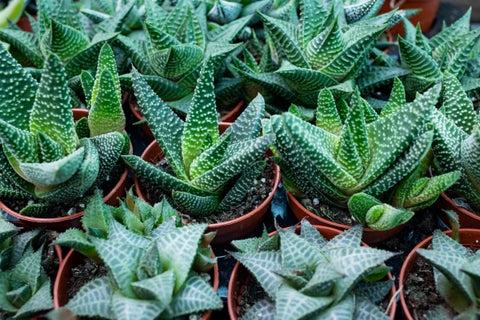
-
Haworthia
Haworthia cymbiformis ‘Variegata’ is an eye-catching succulent with thick, fleshy leaves resembling a boat and decorated with light green and white transverse stripes. These attractive rosettes can reach 3 inches (8 cm) tall and 4 inches (10 cm) in diameter. During the mid-spring to the early summer season, you’ll find delicate tubular flowers – ranging from white to pale pink with brownish-green veins – growing on 8-inch (20 cm) long inflorescences.
Care tip: Succulents like Haworthia cymbiformis ‘Variegata’ is relatively slow-growing and can stay in the same pot for many years. However, to keep them in optimal health and vigor, they should be repotted into newly-prepared soil every two to three years.
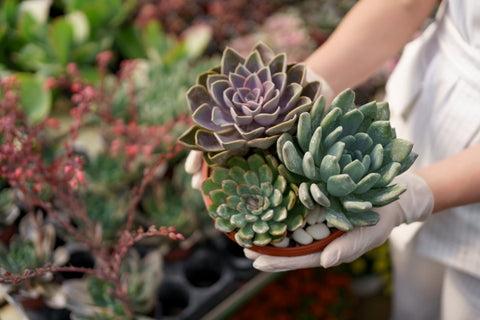
-
Echeveria
This gorgeous small succulent, Graptoveria ‘Lovely Rose’ or Echeveria ‘Lovely Rose’, is characterized by its plump, juicy gray-green leaves that cluster together in an eye-catching rose-like shape on the top of a bare stem.
Care tip: Caring for Lovely Rose follows the same basic guidelines as most succulents. It should be planted in a soil mixture of peat, sand, or other grit, topsoil, and compost.
Full sun is preferable. They can grow in partial sun, although not as vigorously.
These plants require excellent drainage and moderate water. Determining when to water can be done by sticking your finger in the soil – if it is dry several inches down or the fleshy leaves appear shriveled, then it is time to water. When you put too much water, it can cause root rot and invite various types of pests to infest the plant.
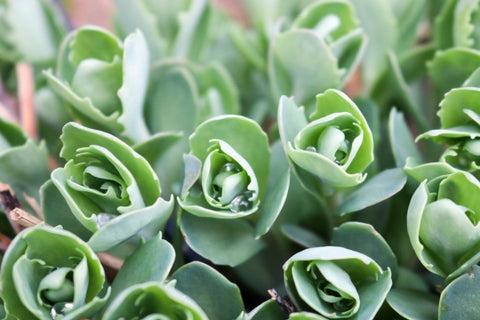
-
Crassula
Crassula is a genus of succulents that has over 350 species found in various parts of the world. Their leaves can come in different sizes, shapes, and colors. When identifying a Crassula, look at your succulent’s leaves which grow in pairs and line up symmetrically. Unlike cacti, Crassula has triangular, fleshy leaves, but some types will have more rounded or egg-like leaves. Crassula plants come in a range of sizes – from short ground-covering varieties to those trailing ones and are ideal for hanging baskets, to shrubs reaching up to 6 feet tall in warm weather climates. In late winter or early spring, mature plants will produce beautiful blooms.
Care tip: Crassula plants need well-draining soil and should be planted in special succulent-formulated sandy and rocky blends. The ideal soil environment is slightly acidic, but even extreme pH levels are rarely fatal to the plant. On the other hand, wet and soggy soils can easily cause their roots to rot, so these must be avoided. Only water heavily when the soil is dry to the touch (approximately every two weeks).
Read more : When Is The Ball Drop
Crassula plants need partial shade during the hottest parts of the summer and full sun for their most vibrant color. Outdoors, a spot that has morning sun and afternoon shade is ideal. However, it should not be exposed to too much direct sunlight to avoid scorched leaves.
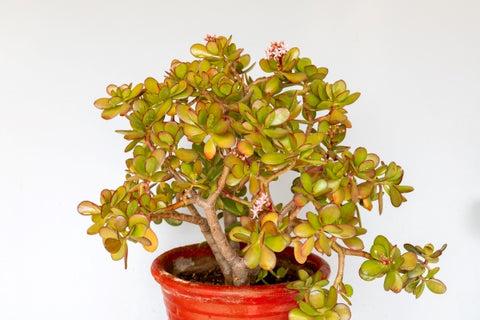
-
Jade Plant
With their thick, woody stems and oval-shaped leaves, jade plants have a very attractive tree-like look, making them great for decoration in any home. With proper care, these plants can last for many years and even be passed down from generation to generation. If grown indoors, they can reach heights of up to three feet or more.
Jade plants do well in warm, dry environments typically found in homes. During the growing season (spring and summer), it’s necessary to keep the plant hydrated, while during the dormant season (fall and winter) you should let the soil dry out. The soil mustn’t be overly wet as jade plants are vulnerable to rotting.
For those living in a climate with mild, dry temperatures throughout the year (Zone 10 and higher), jade plants can be planted outside as part of a landscape. However, since they are easily damaged by cold, it’s recommended to keep them in pots and bring them indoors whenever temperatures drop below 50°F (10°C).
Care tip: Jade plants need to be exposed to at least 6 hours of bright light each day. Younger jade plants should receive indirect sunlight, while larger and more established plants can be placed in a spot with more direct sunlight.
They thrive when they are kept in temperatures ranging from 65° to 75°F (18° to 24°C) during the day, but prefer slightly cooler weather at night and during winter months, with temperatures reaching as low as 55°F (13°C).
During the spring and summer months, when jade plants are actively growing, they need more water compared to other times of the year. Make sure to thoroughly moisten the soil rather than simply wetting the surface. Then, wait until most of the moisture has been absorbed before giving your plant another drink. Depending on how dry the air is in the area where you keep your jade plant, you may need to water it once a week or maybe even once a month.
When the jade plant goes into a dormancy period during fall and winter, it will require much less water. During this time, it’s best to let the soil dry completely between waterings since well-established plants only need one or two waterings for the entire period.
What Succulents Need to Grow
Sun
Succulents need plenty of sunlight to grow, so ensure they’re placed in an area that gets at least six hours of direct sun every day.
Soil
Succulents need soil that is well-draining and doesn’t stay soggy for long periods. For better drainage, you can use a cactus mix or regular potting soil with added perlite or pumice.
Fertilizer
Fertilizing your succulent once every few months during the growing season will help it stay healthy. A balanced liquid fertilizer is a good choice; make sure to dilute it at half-strength before applying.
Water
Succulents need to be watered thoroughly but infrequently. Water the plant until it is moist throughout and then allow the topsoil to dry out completely before watering again.
When to Repot Succulents
Read more : When Does Aria Find Out Ezra Is Board Shorts
It’s important to know when to repot your succulents to give them the best chance at thriving. Generally, it would be best if you repotted your succulent every two years or so. If you notice the plant is big enough compared to its pot or its roots are coming out of the drainage holes, it may be time for a new pot. In addition, changing pots is also the perfect time to change “worn-out” soil. Repotting can help keep your succulents healthy and prevent them from becoming root-bound.
How to Repot Succulents
Repotting succulents is a relatively simple task—with a few simple steps and careful preparation, you can ensure that they thrive in their new home. Start by gathering the necessary materials such as succulent potting soil a suitable pot with drainage holes, and gloves to protect your hands. Then, follow the five steps outlined below to carefully remove the succulent from its old container, replace the soil, water it thoroughly, and place it in an ideal spot with plenty of natural light.
With these easy steps, you should be able to successfully repot your succulents in no time.
Step 1: Preparation
Once your succulent outgrows its original container, it’s also the perfect time to replace the soil. The first step is to prepare the new pot with fresh potting media. Make sure it has adequate drainage holes. It is important to use potting media specifically designed for succulents and cacti since a regular potting mix can become waterlogged, leading to root rot.
Step 2: Removing the Succulent
Gently remove the succulent from its old container. If it is stuck, gently tap on the sides of the old pot until it loosens. Be sure to keep the roots intact as much as you can and avoid breaking any stems or leaves.
Step 3: Replacing the Soil
Gently shake off any excess dirt from the succulent and discard the old container. Then, add a fresh layer of potting soil best suited for succulents at the bottom of the new pot. Gently place the succulent and spread the roots by hand. Continue to add potting soil until it almost covers the space between the lowest leaves and the stem—not too much that it reaches the leaves.
Step 4: Watering
Be sure to water it thoroughly. This will help settle the soil around the plant’s roots, aerate the soil, and create more even growth over time.
Step 5: Finishing Touches
When your succulent arrives in its new home, make sure to place it in a spot with plenty of adequate air circulation and sunlight. It’s also important to give your succulent enough space so that the leaves don’t touch each other or become overcrowded. Once everything is set up, you can enjoy watching your succulent thrive!
These simple steps will help ensure that your succulents stay healthy and happy for the following years. With just a bit of preparation and care, you can keep them looking astonishing—and repotting them every few years will help ensure they continue to flourish.
Tips for Successful Repotting
When repotting your succulents, there are a few things that help achieve successful results. Firstly, always use a pot with adequate drainage holes to allow extra water to escape. Next, make sure the soil is fresh and light for optimal air circulation around the roots. Finally, be sure to place your succulent in an area with plenty of natural light so that it can thrive.
Best Potting Soil for Succulents
Succulents require sandy potting media that contains perlite or sand in order to ensure proper drainage. This type of soil is the most effective for succulents. Perlite is a volcanic substrate that contains a great amount of water. When heated to temperatures as high as 1700⁰F (900⁰ C), the contained water evaporates and the particles expand like popcorn, creating a lightweight but sterile mineral that can be used in the fields of horticulture, agriculture, and home gardening.
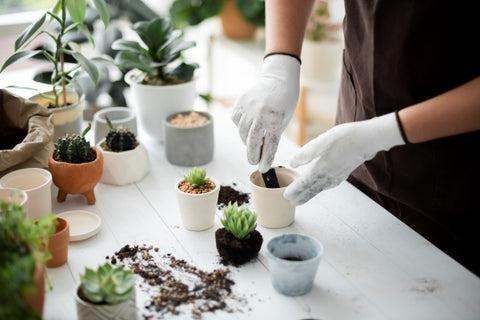
Conclusion
Repotting succulents is a great way to give them the best chance at thriving and staying healthy for many years to come. With the right supplies, preparation, and a few simple steps, you can easily repot any succulents and be rewarded with lush, vibrant growth. By giving your succulents the special care and attention they need, you will be rewarded with a beautiful display of greenery in your home or garden. So don’t hesitate to repot those succulents-it’s easy and well worth the effort!
Source: https://t-tees.com
Category: WHEN
